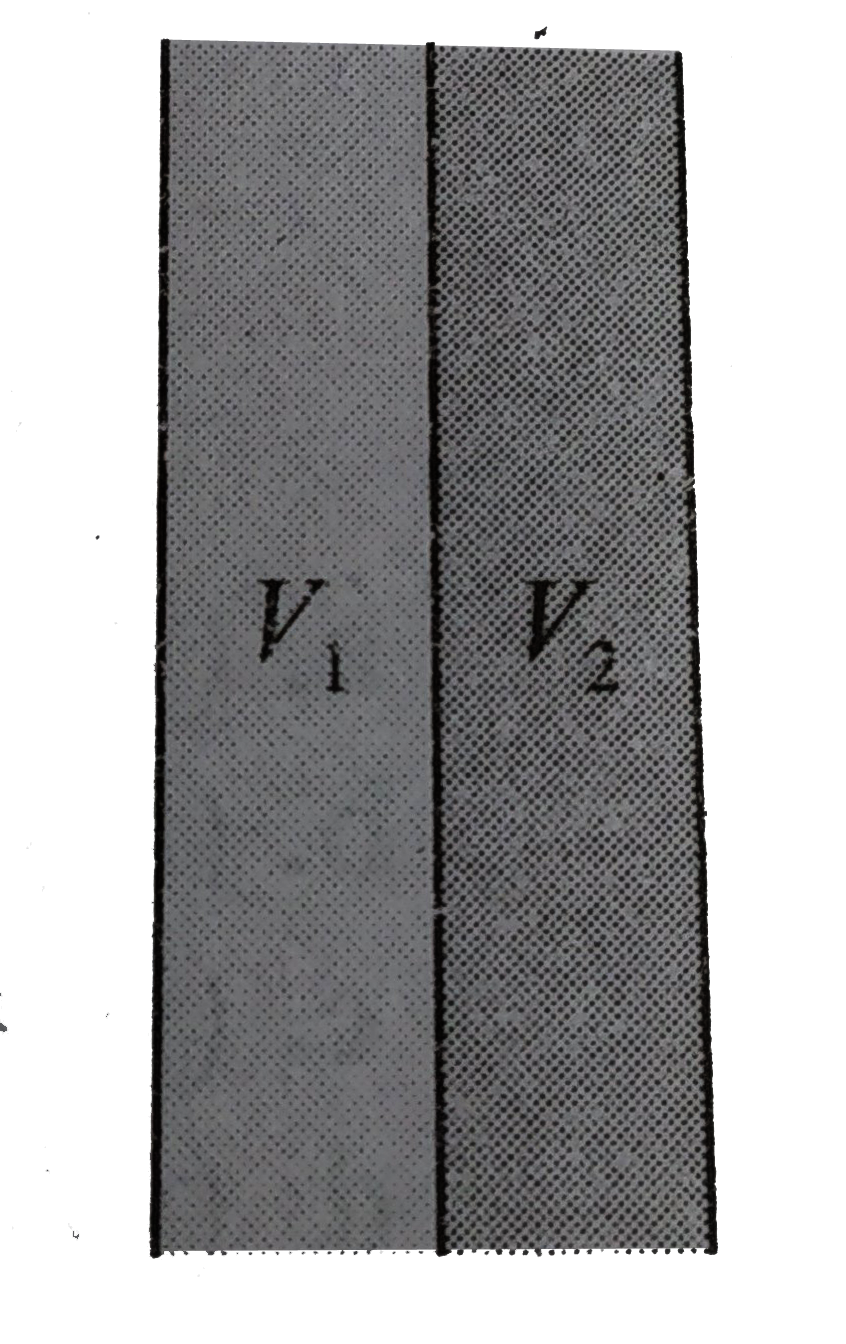In a region of uniform electric field , as an electron travels from A to B, it slows from uA=6.1×106m/s to uB=4.5×106m/s . What is its potential change ΔV=VB−VA in volts ?
18
−18
+48
−48
To find the potential change ΔV=VB−VA as an electron travels from point A to point B in a uniform electric field, we can use the relationship between kinetic energy and electric potential energy.
1. Identify Initial and Final Velocities:
- Given:
- uA=6.1×106m/s (initial velocity at point A)
- uB=4.5×106m/s (final velocity at point B)
2. Calculate Initial and Final Kinetic Energies:
- The kinetic energy (KE) of an electron is given by the formula:
KE=12mu2
- The mass of an electron m is approximately 9.1×10−31kg.
- Calculate KEA and KEB:
KEA=12mu2A=12×(9.1×10−31)×(6.1×106)2
KEB=12mu2B=12×(9.1×10−31)×(4.5×106)2
3. Calculate the Change in Kinetic Energy:
- The change in kinetic energy ΔKE is given by:
ΔKE=KEB−KEA
4. Relate Change in Kinetic Energy to Change in Electric Potential Energy:
- The work done on the electron by the electric field is equal to the change in kinetic energy:
ΔKE=−qΔV
- Here, q is the charge of the electron, which is approximately −1.6×10−19C.
5. Calculate the Potential Change ΔV:
- Rearranging the equation gives:
ΔV=−ΔKEq
- Substitute ΔKE and q to find ΔV.
6. Convert to Electron Volts (if necessary):
- Since 1eV=1.6×10−19J, you can convert the result from Joules to electron volts if needed.
Final Calculation:
Now, let's calculate the values step by step.
1. Calculate KEA and KEB:
KEA=12×(9.1×10−31)×(6.1×106)2=12×(9.1×10−31)×(3.72×1013)≈1.69×10−17J
KEB=12×(9.1×10−31)×(4.5×106)2=12×(9.1×10−31)×(2.025×1013)≈9.19×10−18J
2. Calculate ΔKE:
ΔKE=KEB−KEA=9.19×10−18−1.69×10−17=−7.71×10−18J
3. Calculate ΔV:
ΔV=−ΔKEq=−−7.71×10−18−1.6×10−19≈48.44V
Conclusion:
Thus, the potential change ΔV=VB−VA≈48.44V.
- Given:
- uA=6.1×106m/s (initial velocity at point A)
- uB=4.5×106m/s (final velocity at point B)
- The kinetic energy (KE) of an electron is given by the formula:
KE=12mu2
- The mass of an electron m is approximately 9.1×10−31kg.
- Calculate KEA and KEB:
KEA=12mu2A=12×(9.1×10−31)×(6.1×106)2
KEB=12mu2B=12×(9.1×10−31)×(4.5×106)2
- The change in kinetic energy ΔKE is given by:
ΔKE=KEB−KEA
- The work done on the electron by the electric field is equal to the change in kinetic energy:
ΔKE=−qΔV
- Here, q is the charge of the electron, which is approximately −1.6×10−19C.
- Rearranging the equation gives:
ΔV=−ΔKEq
- Substitute ΔKE and q to find ΔV.
- Since 1eV=1.6×10−19J, you can convert the result from Joules to electron volts if needed.
Now, let's calculate the values step by step.
KEA=12×(9.1×10−31)×(6.1×106)2=12×(9.1×10−31)×(3.72×1013)≈1.69×10−17J
KEB=12×(9.1×10−31)×(4.5×106)2=12×(9.1×10−31)×(2.025×1013)≈9.19×10−18J
ΔKE=KEB−KEA=9.19×10−18−1.69×10−17=−7.71×10−18J
ΔV=−ΔKEq=−−7.71×10−18−1.6×10−19≈48.44V
Thus, the potential change ΔV=VB−VA≈48.44V.
Topper's Solved these Questions
- BOOK - AAKASH INSTITUTECHAPTER - ELECTROSTATIC POTENTIAL AND CAPACITANCE EXERCISE - ASSIGNMENT (SECTION-A) Objective Type Questions (Only one answer)47videos
ELECTROSTATIC POTENTIAL AND CAPACITANCE
- BOOK - AAKASH INSTITUTECHAPTER - ELECTROSTATIC POTENTIAL AND CAPACITANCE EXERCISE - SECTION-B (OBJECTIVE TYPE QUESTIONS (ONLY ONE ANSWER) )1videos
ELECTROSTATIC POTENTIAL AND CAPACITANCE
- BOOK - AAKASH INSTITUTECHAPTER - ELECTROSTATIC POTENTIAL AND CAPACITANCE EXERCISE - ASSIGNMENT SECTION - D13videos
ELECTROSTATIC POTENTIAL AND CAPACITANCE
- BOOK - AAKASH INSTITUTECHAPTER - ELECTROMAGNETIC WAVESEXERCISE - ASSIGNMENT SECTION - D Assertion-Reason Type Questions25videos
ELECTROMAGNETIC WAVES
- BOOK - AAKASH INSTITUTECHAPTER - GRAVITATION EXERCISE - ASSIGNMENT SECTION - D (ASSERTION-REASON TYPE QUESTIONS)16videos
GRAVITATION
Similar Questions
Find the change in electric potential energy , ΔU as a charge of (a) 2.20×10−6C. (b) −1.10×10−6C moves from a point A to a point given that the change in electric potential between these points is ΔV=VB−VA=24.0V
View SolutionPoint A is located 0.25 m away from a charge of −2.1×10−9C. Point B is located 0.50 m away from the charge. What is the electric potential difference V_(B)- V_(A) between these two points ?
View Solution
Knowledge Check
- Question 1 - Select One
In a region of uniform electric field , as an electron travels from A to B, it slows from uA=6.1×106m/s to uB=4.5×106m/s . What is its potential change ΔV=VB−VA in volts ?
A18B−18C+48D−48 - Question 2 - Select One
In a region of uniform electric field, as an electron travels from A to B, it slows from
vA=6.1×106m/s to vB=4.5×106m/s. The potential change
ΔV=VB−VA in volts nearly.A18B−18C+48D−48 - Question 3 - Select One
In a region of uniform electric field as an electron travels from A to B it slows from UA=6.1×106m/stoUB=4.5×106 m/s . What is its potential change ΔV=VB−VA in volts ?
A18B−18C+48D−48
In a certain region of space a uniform and constant electric field and a magnetic field parallel to each other are present. A proton is fired from a point A in the field with speed v=4×104m/s at an angle of α with the field direction. The proton reaches a point B in the field where its velocity makes an angle β with the field direction. If sinαsinβ=√3. Find the electric potential difference between the points A and B. Take mp(mass of proton) =1.6×10−27kg and c(magnitude of electronic charge)=1.6×1019C.
View SolutionIn a certain region of space a uniform and constant electric field and a magnetic field parallel to each other are present. A proton is fired from a point A in the field with speed V=4×104m/s at an angle of α with the field direction. The proton reaches a point B in the field where its velocity makes an angle β with the field direction. If sinαsinβ=√3. Find the electric potential difference between the points A and B. Take mp (mass of proton) =1.6×10−27kg and e (magnitude of electronic charge) =1.6×10−19C.
View SolutionAn electron traveling in a uniform electric field passes from a region of potential V1 to a region of higher potential V2. Then
 View Solution
View SolutionIn moving from A to B along an electric field line, the work done by the electric field on an electron is 6.4×10−19J. If ϕ1andϕ2 are equipotential surfaces, then the potential difference VC−VA is.
 .View Solution
.View SolutionThe energy of incident radiation, which emits the electrons with a velocity of 2.5×106 m/s and work function 1.8 e V , is
View Solution

